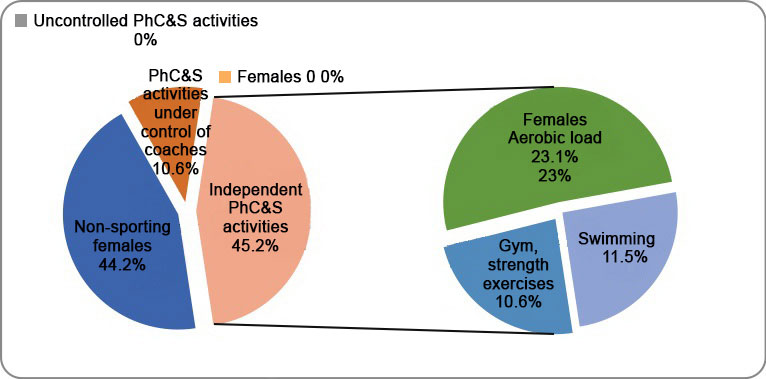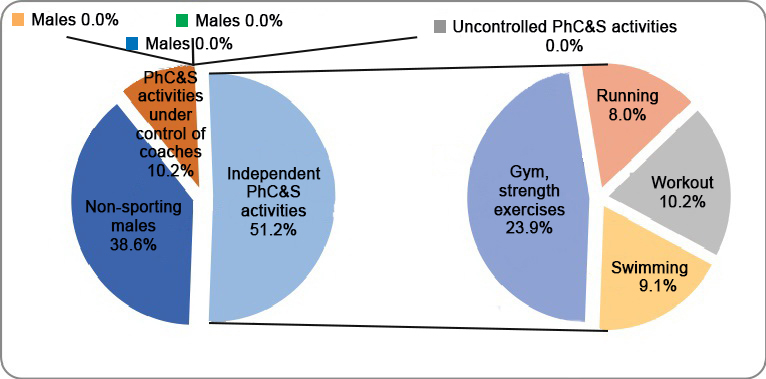Gender-specific myocardial electrophysiology rating in uncontrolled sporting groups
Фотографии:
ˑ:
PhD, Associate Professor I.A. Pogonysheva1
PhD, Associate Professor D.A. Pogonyshev1
Master's student N.V. Kurtukova1
1Nizhnevartovsk State University, Nizhnevartovsk
Keywords: students, computerized cardiac functionality screening system, cardiovascular system CardioVisor-06c, myocardial electrophysiology, physical load, premorbid conditions.
Introduction. Currently, the study of adaptation mechanisms of the human body, its resistance to unfavourable environmental factors and physical loads is still of considerable interest. Moreover, its relevance only increases in the hypocomfortable climatic conditions of the North. The longitudinal studies of the morphofunctional state of the body of the younger generation have revealed a decrease in their functional indicators and an increase in the number of individuals with disharmonious physical development and premorbid conditions [1, 2, 9]. Besides additional physical load, sporting young males and females of the Khanty-Mansi Autonomous Region – Yugra are affected by adverse climatic and geophysical factors, which increase the load on all physiological systems [6, 7]. Over the past decade, there has been a clear tendency towards an increase in the number of students attending gyms and fitness clubs, some - under control of professional coaches, others - independently, out of a well-organized training process, which poses a threat of inadequacy of physical load to the functional capacities of the body with the subsequent development of overtraining conditions and bodily systems and organs malfunction.
Objective of the study was to analyze the ECG dispersions, identify potential premorbid conditions in myocardial electrophysiology in uncontrolled (self-reliant) male and female sport activists.
Methods and structure of the study. One of the priority directions in functional diagnostics is development of the research methods for myocardial electrical instability and non-invasive evaluation of myocardial electrophysiology [3]. The analysis of myocardial electrophysiology using dispersion mapping is practically approved, since the circulatory system adaptability depends on the functional state of the myocardium, its ability to adequately respond to loads of various intensity. The dispersion mapping method is successfully used in sports medicine for the purpose of early diagnostics of premorbid disorders in myocardial electrophysiology [4]. At the first stage of the study, the subjects were surveyed by questionnaire to single out from the general sample those, engaged in systemic sports and physical trainings under control of professional coaches, within a well-organized training process, and those doing sports independently. The total number of respondents – 192 (104 girls and 88 boys). At the second stage, we analyzed the dispersion changes in the electrocardiogram and functional state of the myocardium of the students of Nizhnevartovsk State University engaged in physical education and sports activities without professional control. The diagnostics was carried out using the computerized cardiac functionality screening system "CardioVisor-06c". 92 students (47 girls and 45 boys) aged 18 to 22 years participated in the study. The following indices were diagnosed: index of electrophysiological changes in the myocardium -"Myocardium", which integral index ranges from 0 to 100% (norm – <15%) and dispersion parameters categorized into 9 groups (G1-G9) indicating the degree of manifestation and localization of electrophysiological dysfunctions in the atrial and ventricular myocardium in the depolarization and repolarization phases [5, 8].
Results and discussion. The gender distribution of students depending on the degree of their involvement in physical culture and sports (PhC&S) activities is illustrated in Figures 1 and 2. According to the questionnaire survey, 45.2% of girls and 51.2% of boys are engaged in additional physical exercises out of a professionally organized training process. In the group of girls, 10.6% of respondents are engaged in anaerobic (strength) practices, 23.1% practice aerobic exercises in a gym, 11.5% swim (see Fig. 1). In the male sample, 23.9% of subjects practice strength exercises in a gym, 10.2% do workouts, 9.1% swim, 8% of young males are into aerobic exercises (running) (see Figure 2).

Fig. 1. Distribution of young females depending on degree of involvement into physical culture and sports activities, %

Fig. 2. Distribution of young males depending on degree of involvement into physical culture and sports activities, %
Based on the analysis of dispersion changes in the electrocardiogram, the index of electrophysiological changes less than 16%, indicating the absence of myocardial disorders, was registered in 57.4% of female students; their "heart profile" was characterized by green tones. The premorbid conditions of the myocardium ("Myocardium" value ranging from 16 to 19%) were observed in 29.8% of girls. 12.8% of the examined female sample were diagnosed with pathological changes ("Myocardium" index value exceeding 20%), quasiepicardium in the screen was characterized by predominantly red tones. The "Myocardium" values less than 16% indicating the absence of significant deviations were registered in 42.2% of young males. The premorbid cardiac conditions were observed in 35.6% of boys, 22.2% of them had pronounced pathological changes, the visual heart profile was characterized by predominantly red tones (see Table 1). According to the values of the "Detailization" index, 20% of the young men and 12.8% of the girls had pre-pathological changes in parameters G1 and G2, characterizing the processes of depolarization of the right and left atriums, respectively. Differences in variances showing the presence of intraventricular blockades (G8) were not observed in the subjects. In terms of the "Detailing Code" index, 20% of young males and 12.8% of young females were diagnosed with pre-pathological changes of G1 and G2 parameters, which characterize the right and left atrial depolarization process. The dispersion abnormalities, testifying to the presence of intraventricular heart blocks (G8), were not detected in the subjects.
Table 1. Distribution of index of electrophysiological changes in the myocardium in boys and girls, %
|
Value Sex |
< 16% |
16-19% |
> 20% |
> 47% |
|
Boys |
42.2 |
35.6 |
22.2 |
– |
|
Girls |
57.4 |
29.8 |
12.8 |
– |
Ventricle myocardium repolarization disturbances, which characterize G5 and G6 indices, were found in 28.9% of males and 17% of their female peers, most often this condition is caused by chronic overstrain of the cardiovascular system. An increase in G5 and G6 values may also indicate insufficient myocardial oxygenation. G9 refers to the most sensitive indices of premorbid and pathological reactions of the ventricular myocardium, its increase is indicative of the myocardial depolarization abnormalities. Excess of G9 standard values was registered in 15.5% of male athletes. Such a situation can be observed both in case of ventricular hypertrophy and in case of left ventricular myocardial ischemia. Simultaneously increasing values of the "Myocardium" index and G1-G9 indices, which indicate significant electrophysiological abnormalities, were found in 8.9% of male subjects. The females did not have such abnormalities.
Conclusion. Early diagnostics of pre-pathological conditions and blood circulation system dysfunctions in girls and boys, for whom significant physical loads are not recommended, will make it possible to avoid accidents in the training process and prevent the development of overtraining conditions and bodily systems and organs malfunction. The students with the premorbid characteristics of the "Detailization" and possible pathological changes were offered to undergo an further medical examination and consult a cardiologist.
References
- Baranov A.A., Kuchma V.R., Skoblina N.A. et al. Osnovnye zakonomernosti morfofunktsionalnogo razvitiya detey i podrostkov v sovremennykh usloviyakh [Basic laws of morphofunctional development of children and adolescents in modern conditions]. Vestnik Rossiyskoy akademii meditsinskikh nauk [Herald of the Russian Academy of Medical Sciences], 2012, no. 12, pp. 35–40.
- Bokareva N.A. Veduschie faktory, formiruyuschie fizicheskoe razvitie sovremennykh detey megapolisa Moskvy. Dis. dokt. med. nauk [Leading Risk Factors for Disorders of the Morphofunctional Status in Children and Adolescents. Doctoral diss. (Med.)]. Moscow, 2014, 272 p.
- Ivanov G.G., Sula A.S. Metod dispersionnogo kartirovaniya EKG v klinicheskoy praktike [The method of ECG Mapping Dispersion in Clinical Practice]. Moscow, 2008, 46 p.
- Ivanov G.G., Aleksandrova M.R., Dvornikov V.E. et al. Uspekhi klinicheskogo primeneniya metoda dispersionnogo kartirovaniya [Dispersion mapping method: success of clinical application]. Vestnik RUDN. Ser. Meditsina, 2013. [Electronic resource]. Available at: https://cyberleninka.ru/article/n/uspehi-klinicheskogo-primeneniya-metod... (date of access: 25.02.2018).
- Ispolzovanie pribora «KardioVizor-06s» dlya skriningovykh obsledovaniy. Metod dispersionnogo kartirovaniya. Rukovodstvo dlya vrachey [CardioVisor-06s device for screening studies. Dispersion mapping method. Doctors' guide]. Moscow, 2004, 23 p.
- Pogonysheva I.A., Pogonyshev D.A. Funktsionalnoe sostoyanie serdtsa studentov, zanimayuschikhsya sportom v usloviyakh Severa [Academic sports in Far North: sporting students' heart functionality tests]. Teoriya i praktika fiz. kultury, 2017, no. 6, pp. 99-101.
- Pogonysheva I.A., Pogonyshev D.A. Osobennosti morfofunktsionalnykh parametrov organizma molodykh lyudey, prozhivayuschikh v raznykh klimatogeofizicheskikh usloviyakh okruzhayuschey sredy [Specific morphofunctional characteristics of young people living in different climatic and geophysical environmental conditions]. Vestnik Nizhnevartovskogo gosudarstvennogo universiteta, 2017, no. 1, pp. 68-74.
- Programmnoe obespechenie dlya skriningovykh issledovaniy serdtsa KardioVizor-06s: Rukovodstvo polzovatelya [CardioVisor-06c Cardiac Screening Software: User's Manual]. Meditsinskie kompyuternye sistemy [Medical computer systems], 2006. 76 p. [Electronic resource]. Available at: http://www.mks.ru/netcat_files/209_32.pdf
- Yampolskaya Yu.A., Skoblina N.A., Bokareva N.A. Longitudinalnye issledovaniya pokazateley fizicheskogo razvitiya shkolnikov g. Moskvy (1960-e, 1980-e, 2000-e gg.) [Longitudinal studies of physical development indicators in schoolchildren in Moscow (1960s, 1980s, 2000s)]. Vestnik antropologii, 2011, no. 20, pp. 63-70.
Corresponding author: severina.i@bk.ru
Abstract
Based on prior questionnaire survey data, two groups of the Nizhnevartovsk State University students were sampled for the study purposes: Group 1 was composed of the students engaged in systemic sports and physical trainings under control of professional coaches; and Group 2 was made of the uncontrolled (independent) sport activists. At the second stage of the study, the gender-specific myocardial electrophysiology in both of the groups was tested and analyzed using the computerized cardiac functionality screening system CardioVisor-06с. The test data were used to analyze the ECG dispersions, rate the myocardial functionality in the uncontrolled Group 2 – that was exposed, among other things, to the harsh climatic and geographic Northern conditions of extra burden on the bodily physiological systems. The study data were indicative of the premorbid disorders in myocardial electrophysiology in 29.8% and 35.6% of the female and male subgroups, respectively; and possible pathologies in the cardiac function were diagnosed in 12.8% and 22.2% of the female and male subgroups, respectively.



